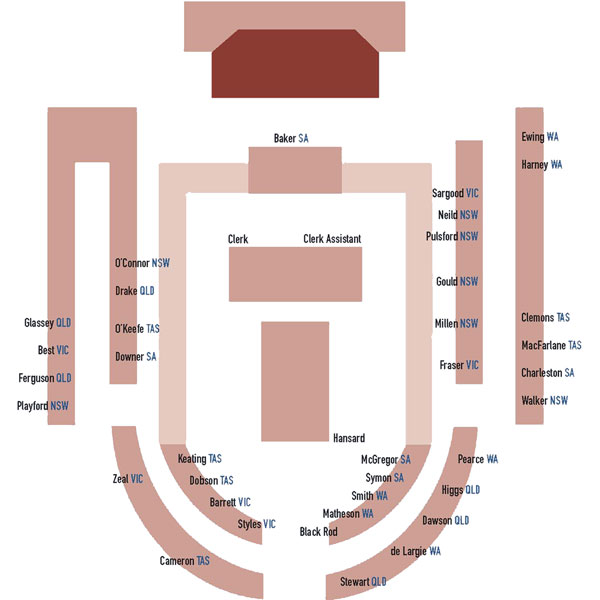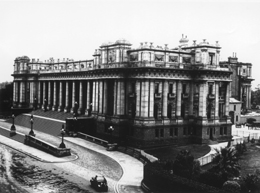Political parties
There were no parties in the proper sense of the word, for though the Protectionists naturally gravitated to the Ministry and Free Traders to the Opposition, all ties were of the loosest character, and many fundamental differences of opinion were concealed under familiar labels.
Alfred Deakin 15 October 1902
There were three major political groupings in the first Parliament: Protectionist, Free Trade, and Labor. In neither house could one group outvote the other two combined. Party discipline was not as strong as it is today, and the fate of bills, and even governments, depended on the quality of arguments advanced in debate.
Senate
While political commentators put the party position in the Senate in 1901 as 11 Protectionist, 17 Free Trade, and 8 Labor, many of the first senators felt that the Senate was an inappropriate place for party politics. Free Trade senators declined to elect a leader, or to present a formal Opposition. Committed supporters of the government were in a clear minority, but senators generally were willing to support the government’s program.
House of Representatives
Although Protectionists claimed to have won 32 seats in the first House of Representatives, Free Trade 27, and Labor 16, a number of members sought a more neutral position than clear alignment with Government or Opposition. Believing that they were elected to establish the legislative framework of the nation, a majority were prepared to compromise on the tariff issue and to support the Barton Government on other great issues facing the first Parliament.
Seating arrangements in the new Parliament followed the traditional pattern, with government ministers seated on the front benches to the right of the presiding officers with backbench supporters of the government behind them, and Opposition members ranged opposite. The leaders of the Government and Opposition sat at the table, and other parties and independents took up the cross benches.
 |
Seating Plan of the Senate, May 1901 |
 |
Seating Plan of the House of Representatives, May 1901 |
The first business of each house was to choose a presiding officer. Senator Sir Richard Chaffey Baker, a framer of the constitution and a former President of the South Australian Legislative Council, was elected President of the Senate with an absolute majority of votes. Frederick William Holder, Premier of South Australia at the time of his election to the House of Representatives, was not opposed in his election as Speaker of that house.
 |
 |
Sir Richard Chaffey Baker, first President of the Senate
Alexander Colquhoun (1862-1941), oil on canvas
Historic Memorials Collection, Parliament House Art Collection |
Sir Frederick Holder, first Speaker of the House of Representatives.
George Webb (1861-1943), oil on canvas
Historic Memorials Collection, Parliament House Art Collection |
The day after the opening of Parliament the members of both houses assembled in the Senate chamber to hear a speech by the Governor-General outlining the government’s legislative program. The Senate spent six days and the House eight debating an Address in Reply to the Governor-General’s speech. Eighty of the 111 members of the first Parliament spoke in this debate, using the occasion to introduce themselves, their convictions, interests and personalities, to each other and to the people of Australia.
Parliament House, Melbourne
 |
Parliament House, Melbourne, circa 1910
Reproduced with the Permission of the Victorian Parliamentary Library |
The first home of the Commonwealth Parliament was Victorian Parliament House in Spring Street, Melbourne. This fine building was loaned, rent free, to the Commonwealth for an indefinite period. It was expected that the federal Parliament would meet in Melbourne for only a few years until the national capital was chosen and a new Parliament House built. In the meantime, the Victorian Parliament met in the Exhibition Building. The selection and development of the national capital site took much longer than expected, however, and the federal Parliament met in Melbourne for 26 years.
|


